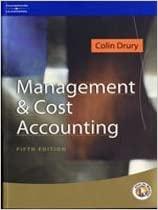Advanced: Demonstration of how a badly designed transfer pricing system can distort decision-making involving the use of
Question:
Advanced: Demonstration of how a badly designed transfer pricing system can distort decision-making involving the use of calculus AB Ltd comprises two divisions. Division A produces the aye - a component sold to outside customers and transferred to division B. Division B produces the bee - each unit of which incorporates one aye in its construction. Divisional Managers are paid an incentive bonus linked to divisional profit.
Demand for the two products from outside customers for the next year is forecast to be as follows:
The marginal cost of producing 1 unit of aye is £20, and that of producing 1 unit of bee (not including the aye) is £25 — in both cases, at all levels of output.
AB Ltd’s Chief Accountant comments that Setting selling prices is simply an exercise in mathematics. Once you understand the cost and revenue structures of a business, then it is an easy matter to find the unique selling price for each product that maxmises profit.
Requirements:
(a) Calculate the unit selling price and output that divisions A and B should adopt for the next year in order to maximise the profit of AB Ltd. (10 marks)
(b) Calculate the unit selling price and output that divisions A and B are likely to adopt in the next year if the manager of division A is instructed to transfer units of aye to division B at ‘market price’ and with no other constraints.
You may assume that divisional managers will always adopt unit selling prices and output levels that maximise the profit of their own division. (10 marks)
(c) Critically evaluate the Chief Accountant’s comment.
Step by Step Answer:






